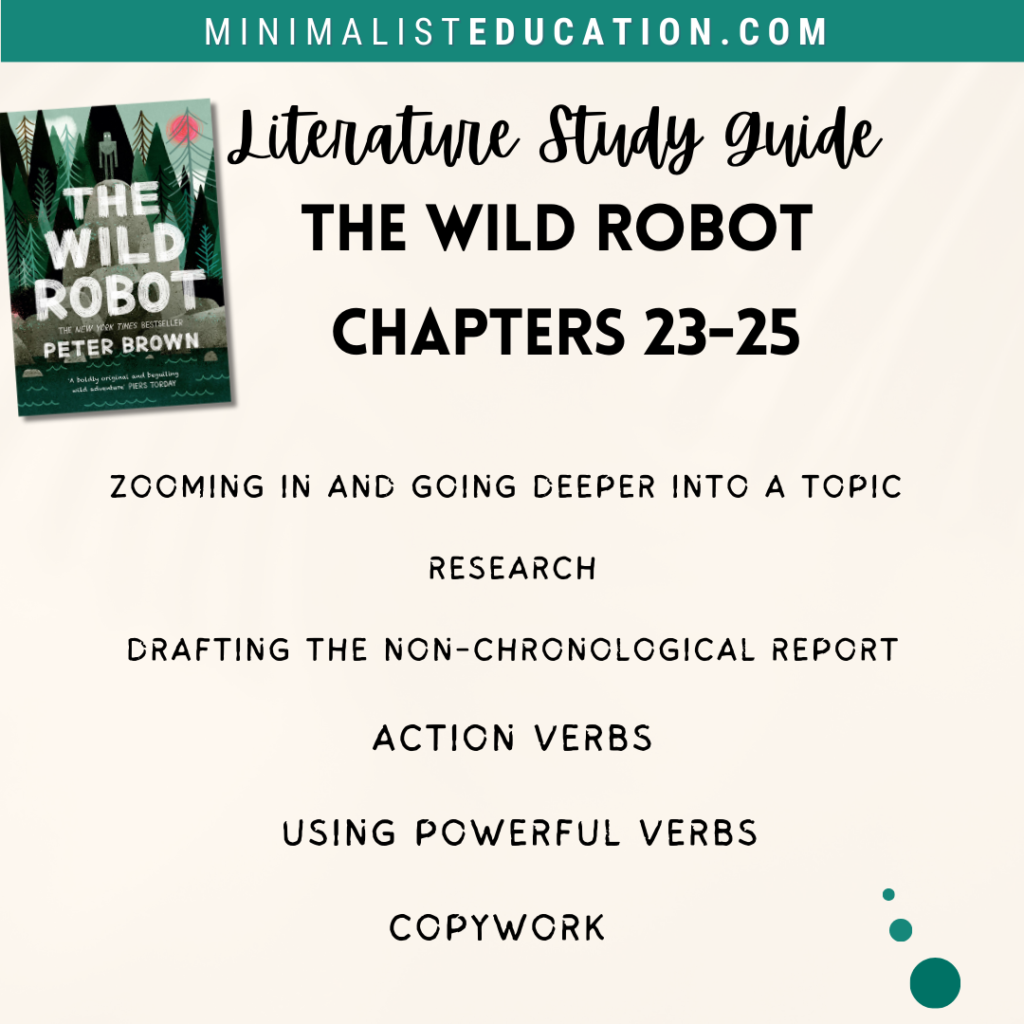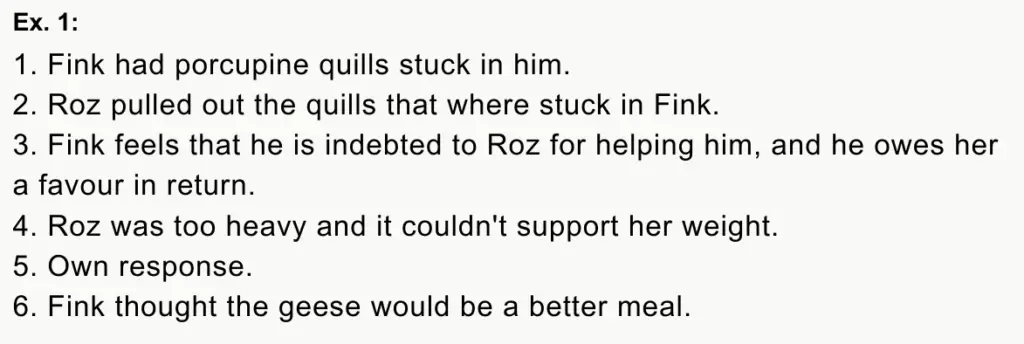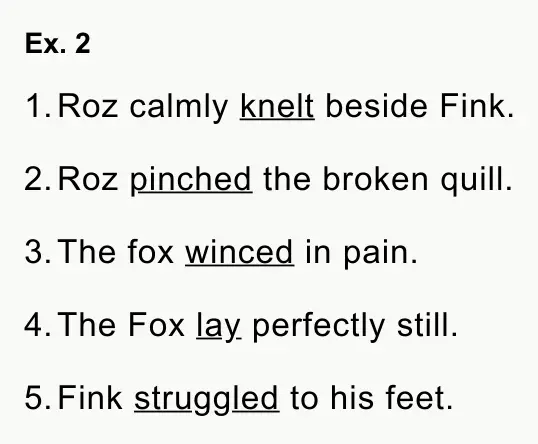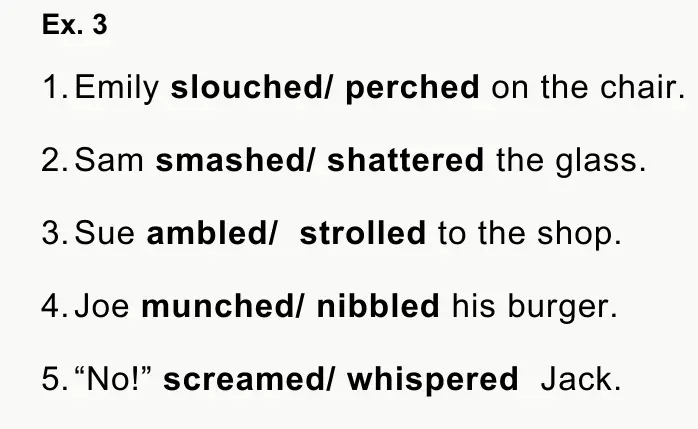Action Verbs: The Wild Robot Chapters 23-25 Study Guide

Only three chapters this week? This is to make room for some serious work on the non-chronological report on camouflage. However, we do have time to squeeze in some reading, and also zoom in on the super important action verbs.
In this post:
- Discussion notes for research and drafting the non-chronological report
- The Wild Robot teaching notes and answers for Week 5 Chapters 23-25
- Download The Wild Robot Study Guide for Week 5 Chapters 23-25
The Wild Robot Chapters 23-25 Study Guide Teaching Notes And Answers
Non-Chronological Report: Zooming in to go deeper
- Ex. 1 Choose three sub-topics to be the focus of the report.
The research done by the kids in last week’s task would have uncovered plenty of information of the topic of camouflage.
But if we get our kids to try and write their report on this huge subject they won’t have the opportunity to gain a deeper perspective on the topic.
For the purpose of the report, we have to help our kids to narrow down this vast topic into something more manageable.
Julie Bogart from Brave Writer has this cool idea called the “topic funnel” to help with that. Imagine it like an actual funnel – you start with this big topic, and then we swirl that topic around in the funnel. As it goes, it gets smaller and smaller, until we end up with a narrow topic to write about.
Now we have narrowed down our focus we can go deeper into it.
Read this article “Narrow and Deep” by Julie Bogart explaining this concept in more detail.
Help your children to choose three sub-topics about camouflage in nature that they can zoom in on as the focus of their report.
For example we have chosen to write about animal camouflage, insect camouflage, camouflage in the ocean. Granted these are still large topics themselves. But doing some more research on these individual topics will help your child decide which aspect they want to write more specifically.
Once your child has decided on their three sub-topics, they will probably need to do some more research. They can write down the information they find for each sub-topic on the Camouflage Report Facts sheet.
Non-Chronological Report: Writing the Draft
- Ex. 2 Start writing a draft of the report!
Children can use the Draft Report template to do this. It can help to have a visual representation of the different elements that they can put into their report.
It is helpful at this stage to go back to the “Hurricanes” non-chronological report template and remind your child of what features to include in their report.
You will probably need to help your child write the introduction. This can be done by adding a general statement about camouflage, or an interesting fact or “Did you know?” information. They can also add a “fun facts”, “did you know” or a glossary/ key terms box. All of these will make their final non-chronological report interesting to look at and engaging to read.
You will probably also need to help them with the conclusion. This can be a summary of the main points written about, a statement explaining the purpose of the report, or a hope or wish for this topic.
While they are writing a draft of this report, have them think about what pictures they could add to their report to make the subject more clearer for readers.
Chapters 23-25
- Ex. 1 Read chapters 23- 25 of “The Wild Robot” then answer the questions.
I wanted kids to have plenty of time to read, research and write their report draft so I have scaled down the amount of reading we have to do for The Wild Robot. I have included some comprehension questions.
To be honest, we just discussed them rather than having the children write out the answers as they were doing plenty of writing this week anyway.

Teaching Action Verbs
- Read the information on what verbs are.
I really wanted to introduce verbs this week and also and explain and demonstrate the effect of choosing effective verbs in writing (or talking). At this stage, using powerful adjectives and powerful verbs will go a long way to improving children’s writing.
Read the discussion notes on what verbs are: A verb is an action word or a being word.
Note that this week we are only going to focus on action verbs.
- Ex. 2 Underline the verbs in the sentences.

Use lots of simple sentences and ask your child what word is the verb in those sentences. If this is the first time your child has encountered the concept of verbs, it may take a few attempts before they understand the concept of what a verb is.
- Ex. 3 Rewrite the sentences and change the boring verb into a more interesting verb that has the same or similar meaning.

Kids can choose their own words, or use the words I’ve given in the word bank.
Why do this activity? Verbs are words for action, but thinking about other possible powerful versions of basic verbs helps make writing more descriptive, exciting and engaging.
Learning and using synonyms of basic verbs will expand children’s vocabularies and improve speaking and writing skills.
Some examples you can share with your child of powerful verb examples are:
Sprinted, galloped or rushed instead of ran
Shouted, whispered or muttered instead of said
Searched, eyeballed or examined instead of looked
Snoozed, slumbered or dozed instead of slept
Notice how each different version of the verb, although broadly meaning the same thing, gives a slightly different meaning.
Writer’s Craft: Powerful Action Verbs
- Read the extract and related analysis.
“Down went the robot, plummeting into the treetops below. She crashed through branch after branch before finally hooking an arm around one.” Chapter 24 page 58
This extract is perfect for showing children how to powerful verbs are used for effect. In this extract, Peter Brown has used powerful verbs to show us how dangerous the situation was for Roz.
“Plummeting” is a powerful word choice that tells us that Roz was falling rapidly and she had no control. “Crashed” tells us that the impact is forceful, giving us the sense of chaos and action.
Crashed, and plummet are action verbs that describe movement. There are many verbs which describe how someone can move e.g. walk, crawl, run, trudge.
- Ex. 5 Make a list of 10 verbs that can be used instead of “walked” (or ran) in the sentence “He walked down the street”.
This task gives the kids a chance to think of their own synonyms instead of the plain verbs walked or ran.
Before I got the kids to do this task, we had a blast acting out different ways of walking and guessing the word. We took turns walking across the room stomping, sprinting, hopping, sneaking while the others had to guess the verb we were trying to show.
- Ex. 6 Copywork
Get your child to copy the passage we just analysed. I actually missed the copywork task this week as the kids were doing plenty of writing for their research.
Download Your Copy of The Wild Robot Study Guide for Chapters 23-25:
I hope you and your kids have as much fun as we did doing the research. Seeing the different ways animals, plants and insects camouflage really left us feeling in awe.
Those of you who have made it this far, I would love to hear how it’s going.
Do you have any suggestions for improvement or activities that you would like to see included in the guide? I actually wanted to incorporate some related art and craft activities but I’m not sure if this would be too much.
Leave a Reply